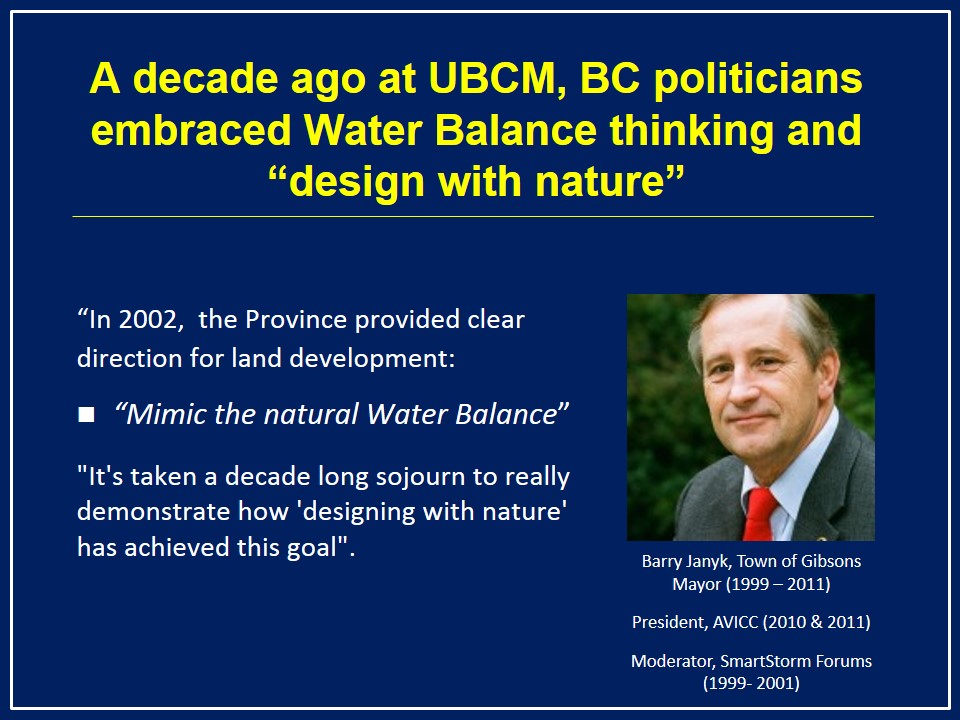Wetland Conservation in a Watershed Health Context: “Watershed Blueprints will help municipalities integrate and better deliver on regulatory requirements,” says Kim Stephens
Note to Reader:
In November 2013, the BC Wildlife Federation Wetlands Program organized a one-day workshop titled “Wetlands, Not Wastelands”. The workshop aimed to strengthen the Metro Vancouver region’s capacity to secure green infrastructure – promoting human health and nature.
The workshop included presentations and discussions on ways to integrate wetland conservation at a municipal and regional level with a variety of tools from policy to built-infrastructure. A presentation by Kim Stephens connected dots between regulatory requirements and actions on the ground.
Design with Nature – Walk the Talk for Sustainable Community Design
In September 2003, the Union of BC Municipalities (UBCM) organized a half-day Urban Forum as part of its Annual Convention. Organized in two halves, the Forum coupled a presentation on a 100-year vision for the Metro Vancouver region with a presentation on an inter-governmental initiative to change the way land is developed and water is used in British Columbia.
“We challenged local government elected representatives to walk the sustainability talk and implement a ‘design with nature’ approach to the planning and design of their communities,” recalls Barry Janyk (Mayor, Town of Gibsons from 2001 through 2011). He was the lead on a 3-person presentation team that also included Kim Stephens and Dipak Basu (City of Chilliwack).
“To protect stream and watershed health, we highlighted that provincial direction is to develop land in a way that mimics the natural Water Balance.”
To Learn More:
To read the complete story about the UBCM presentation, click on Partnership Celebrates Milestone: “Water Balance Model for British Columbia” launched 10 years ago at UBCM Urban Forum.
If We Reduce Our “Water Footprint”…..
 “Every municipality in Metro Vancouver has to manage the raindrops that fall it. The regulatory driver is the Environmental Management Act,” explains Kim Stephens, Executive Director, Partnership for Water Sustainability in BC. “A decade ago, British Columbia was the first jurisdiction in North America to adopt the ‘Water Balance Methodology’ when the Province released Stormwater Planning: A Guidebook for British Columbia. Guidebook direction is ‘mimic the balance’ when land is developed.”
“Every municipality in Metro Vancouver has to manage the raindrops that fall it. The regulatory driver is the Environmental Management Act,” explains Kim Stephens, Executive Director, Partnership for Water Sustainability in BC. “A decade ago, British Columbia was the first jurisdiction in North America to adopt the ‘Water Balance Methodology’ when the Province released Stormwater Planning: A Guidebook for British Columbia. Guidebook direction is ‘mimic the balance’ when land is developed.”
“When the land surface is developed and hardened, below-ground flow paths to streams are eliminated. This has both financial liability and environmental sustainability consequences. When there is too much water during fall and winter wet-weather periods, the result is erosion, instability and movement of gravel and contaminants. When there is too little water during summer dry-weather periods, creeks go dry and fish will not survive.”
“Metro Vancouver municipalities are required to develop and implement watershed-based plans. A watershed blueprint helps to create a picture of how to achieve a desired future condition. If communities reduce their ‘water footprint’, and if local government actions ensure the integrity of groundwater flow, they can then protect watershed and stream health. This is a reason for conserving wetlands.”
To Learn More:
To read a previous story posted previously on the Green Infrastructure community-of-interest, click on Wetlands, Not Wastelands: A Workshop for Metro Vancouver Municipalities (November 19)
To download a PDF copy of the PowerPoint presentation by Kim Stephens, click on Wetlands Conservation in a Watershed Health Context: Watershed Blueprints Will Help Municipalities Integrate and Better Deliver on Regulatory Requirements.



